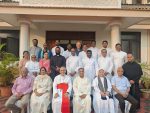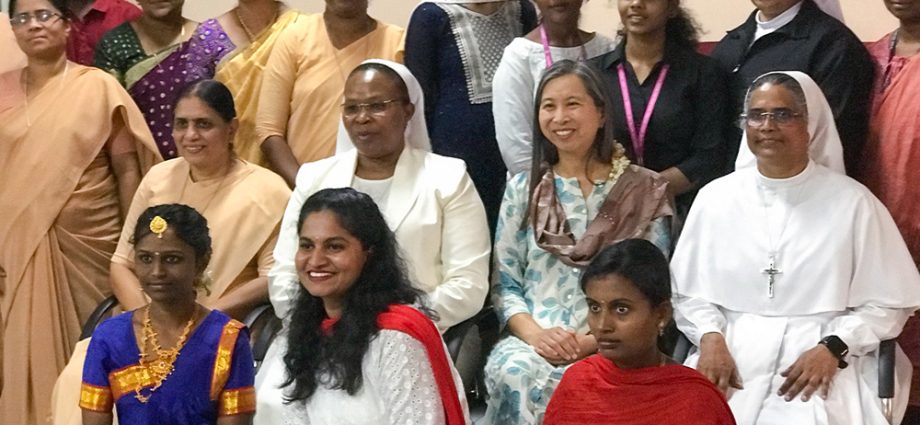By Thomas Scaria
Bengaluru, Sept 26, 2024: Catholic women religious in India have enhanced their youth ministry, with the aim to bring young people closer to the church and their traditions.
“This involves not only working on their faith formation, skills training or academic excellence, but [also] understanding and accepting them as they are with their dreams, weaknesses and strengths,” said Apostolic Carmel Sister Maria Nirmalini, who heads the women’s wing of the Conference of Religious India.
Young people in India, she told Global Sisters Report, are losing their trust in an adult-dominated world and migrate to foreign countries in large numbers for freedom and growth, leaving their parents and their Christian heritage.
Youth distancing from the church was first studied by the National Youth Commission of the Evangelical Fellowship of India in 2012, which found that church attendance had dropped during the teen and young adult years: Only 29 percent of youths continued attending church frequently while in college, and 40-50 percent of students in youth groups reportedly struggle in their faith after graduation.
“It is high time we recognized this dangerous trend and be with the youth,” said Sister Nirmalini, who led the Conference of Religious India until May.
“Youth are not going away from the church, but the church is moving away from them,” added the nun, who has spent decades as an educator.
The women religious’ youth ministry received a boost in May at the conference’s triennial national assembly, which voiced concern over Catholic youths’ distancing from the church, as well as their mass migration. (According to the 2023 Indian Student Mobility Report, about 1.3 million students from India went overseas for studies in 2022, and the report’s authors predict that about 2 million students from India will be studying abroad by 2025.)
In the southern Indian city of Bengaluru, more than 650 major superiors attended the May 14-17 assembly under the theme “Journeying With Hope: Relevance and our Prophetic Response,” a gathering that stressed urgent and appropriate steps to retain and support the youth.
Livin Varghese, a young Catholic who addressed the assembly, told the religious that young people have not gone away from the church, but sometimes, they find the church old-fashioned, irrelevant, ritualistic and boring.
Varghese, a member of the Jesus Youth, an international Catholic movement, regretted that young people feel that the church treats them as “troublemakers more than partakers.”
He also pointed out the dwindling vocations to religious life has something to do with the church’s attitude toward youth.
“Young people can be effective missionaries if they are given a conducive space and roles,” he said, also stressing the need for “redefining the concept of vocation and the roles youth can play in the church.”
The church must also trust, train and include them in its mission, he added.
“My church is sleeping when we are awake; it becomes judgmental when we want to participate,” Varghese said. He urged the religious to think “differently, if you want to work with youth.”
The Catholic religious responded positively to such concerns by reviewing their ministry among the youth and proposed various steps to enhance it “in a spirit of collaboration and synodality,” Nirmalini explained.
“Although the resolution was taken in the assembly of both men and women, the sisters will play significant roles in implementing the youth mission,” she said.
India currently has some 103,000 women religious belonging to nearly 300 congregations.
She said Indian nuns will not only support the existing youth movement in the church, but develop “an exclusive action plan to engage youth in all our activities.”
Sister Molly Mathew, a member of the Missionary Sisters of Mary Help of Christians, told GSR that she coordinates a national project on youth empowerment that has prioritized Christian youth, but is open to other communities, too.
It started in Bengaluru with six women religious congregations taking up the cause, but later extended to other parts of India, including northeastern Indian states.
“The process starts with bringing out the youthfulness among the sisters themselves,” said Sister Mathew, who returned recently after training some sisters in northeastern India.
“Empowering the youth will be effective only when the sisters involved are empowered first,” she said.
Her congregation, which originated in northeastern India, now has more than 1,500 members, most of whom are in their middle age.
“We have taken it as our main mission to work with the youth, mostly among tribal Christians, and make them vibrant members of our church community,” Sister Mathew said.
The nuns also focus on school dropouts and help them complete their education with the National Institute of Open Schooling, a federal government project.
Mathew said the church in northeastern India also promotes lay vocations, such as the Young Apostles of Christ. Helped by nuns, the project trains youth and involves them as catechists and lay missionaries.
Sister Betsy Devasia, a member of the Sisters of the Cross of Chavanod and director of the Women’s Development Centre in Guwahati, northeastern India, has trained more than 800 young women in various trades and found them jobs.
“They are our great strength in witnessing Christ wherever they work,” the 77-year-old nun told GSR.
Sister Bromadine Palokaran, head of the Pune province of the same congregation, said she had found young people active in parishes when she worked six years with youth in Goa, a western Indian state.
However, young people require empathetic listening from the religious, not corrective measures, to face modern challenges like substance use.
“Stop advising the youth and start engaging them, if you want to bring them back to the church,” she said, adding that the youth respond well when they are trusted and respected.
The Bengaluru assembly has acknowledged contributions of the youth movements that keep young people closer to the church.
Besides the Jesus Youth, which works among the university students and working professionals, the church also promotes the Indian Catholic Youth Movement, which focuses on involving young people in parishes.
The assembly also acknowledged some initiatives involving women congregations, such as Project Gems: a 10-year program that tries to empower Catholic youth to avail government jobs in India and limit migration to other countries.
Some 30 women congregations promote this program, which allows young people to grow with the church.
“This is a holistic formation to keep them alive with their faith, church and their families,” said Carmelite of Mary Immaculate Father Roy Kannanchira, the project founder.
“It is sad that we ignore our own children when it comes to their education and employment.” said the priest, who wants to prioritize Catholic youth in the Indian church’s educational and social development programs.
More than 2,000 Catholic students are enrolled in this program, the priest told GSR.
The rising trend of Indian students going abroad, Father Kannanchira said, “is comparatively higher with regard to Christian students from India. … Our aim is to retain them in India and support them.”
One of the congregations associated with the project is Congregation of the Mother of Carmel, which recruited around 650 seventh graders two years ago.
“Our priority is to recruit young people from the Catholic families that have provided vocations to the church and religious [life],” Sister Navya Maria, in charge of the congregation’s faith formation, told GSR.
The 60-year-old nun terms the project as a “giving back” program to show “our gratitude and spiritual responsibility to them.”
Sacred Heart Sister Annie John also said the Gems project is an urgent mission of the church that has “conveniently ignored its children.”
The 63-year-old nun said her Kanjirapally province in Kerala, southern India, has set apart 5 million rupees for training Catholic youth. It currently sponsors 50 students for a 10-year formation program.
“But the irony is that the amount is not even 10% of what we spend for Hindus and Muslims in our social development projects,” she told GSR.
Her congregation pays the annual fee of 20,000 rupees (US$243) for each student in its Gems project. The project provides the students a 30-minute daily online class, motivational talks by government officers, skills developing camps and regular follow-up.
“While the Project Gems team takes care of their academic formation, the sisters carry out their faith formation,” she explained.
Sacred Heart Sister Mareena Mathilakathu, working in the Ujjain Mission in the central Indian state of Madhya Pradesh, has recruited 20 students from Catholic families for the academic and reintegration program, supported by their social development funds.
“We want these children to grow up as good Catholic youths and join government offices eventually,” she told GSR. She too laments that the Catholic Church “invests millions of rupees on development of people in India, but hardly spends anything on our own Catholic youth.”
Sister Nirmalini voiced her support for this project.
“Let us first set our house in order, and develop a culture of working together for a vibrant church in India in the synodal way.”
(This feature first appeared in globalsistersreport.org on September 25, 2024.)











